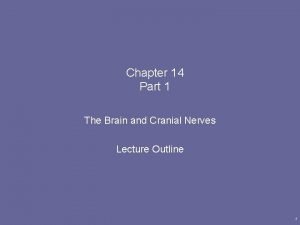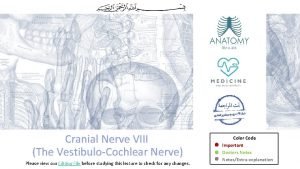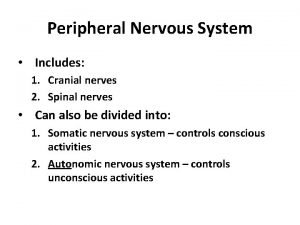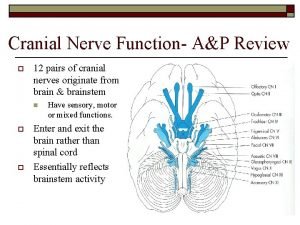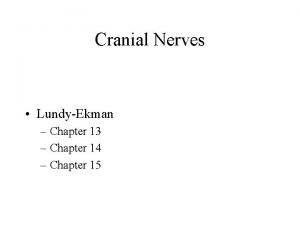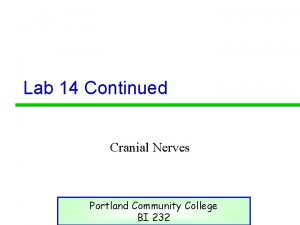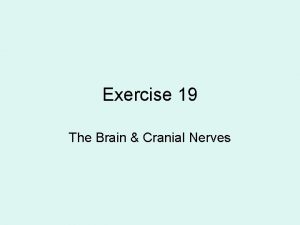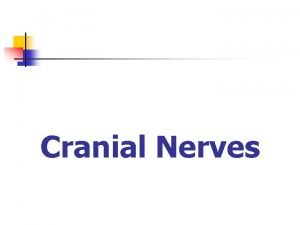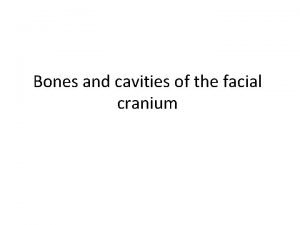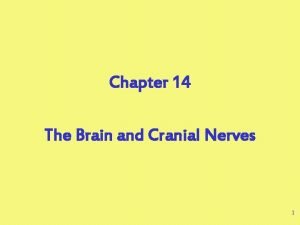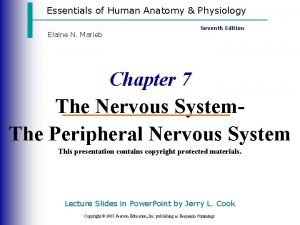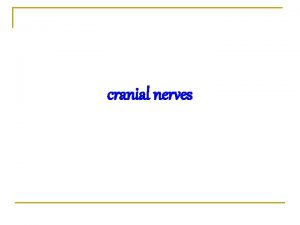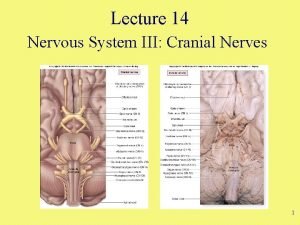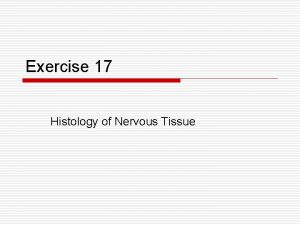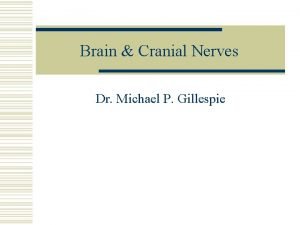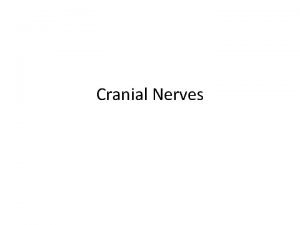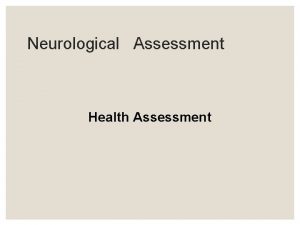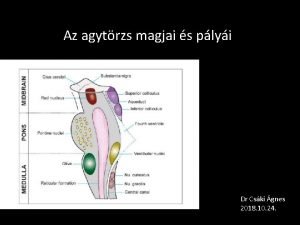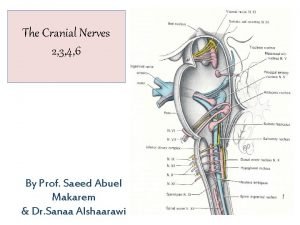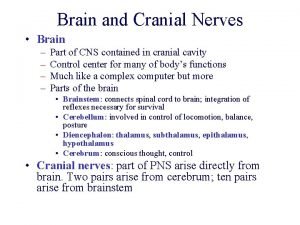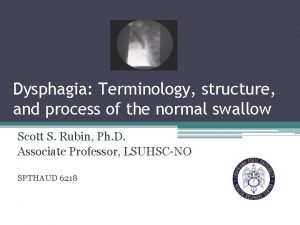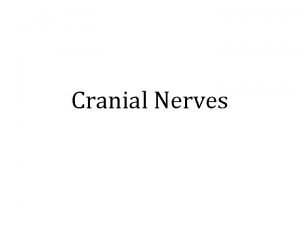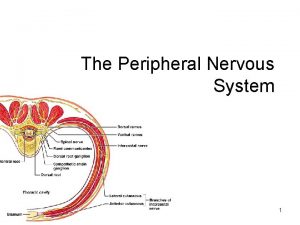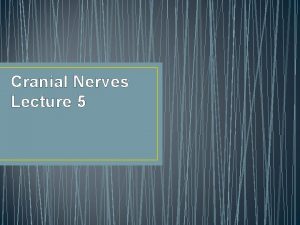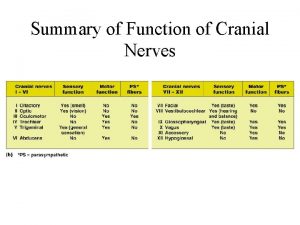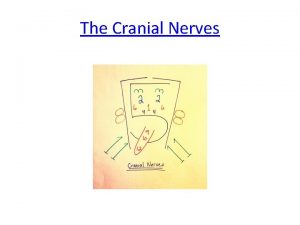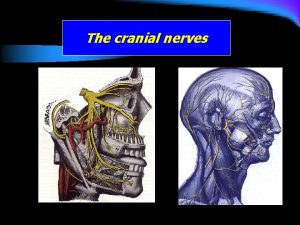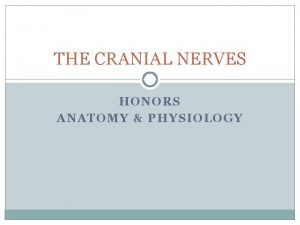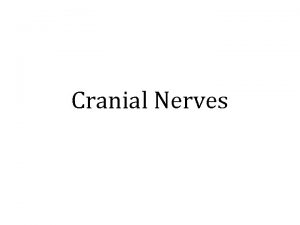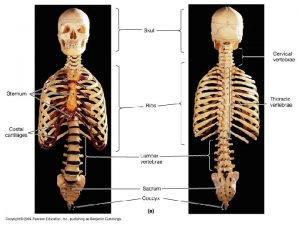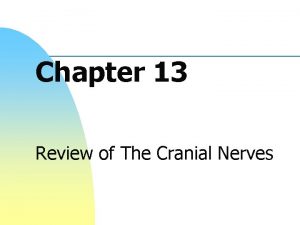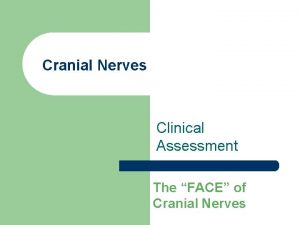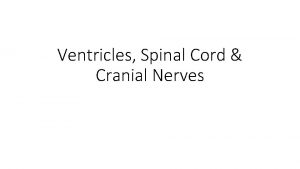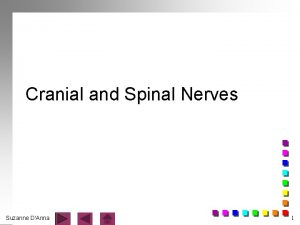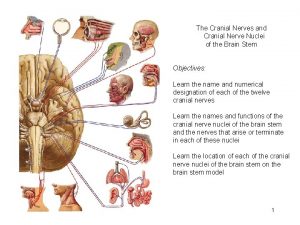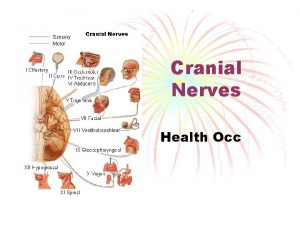The 12 Pairs of Cranial Nerves Figure 14



































- Slides: 35

The 12 Pairs of Cranial Nerves Figure 14. 8

I. OLFACTORY • Transmit the sense of smell. Outside of the CNS they are called olfactory nerves, and inside of the CNS they are called the olfactory tract.

II. OPTIC NERVE • Transmits information from the eye’s retina.

III Occulomotor Nerve • This controls most of the extrinsic muscles of the eye (that move the eyeball).

IV. Trochlear Nerve • Innervates an extrinsic eye muscle

V. Trigeminal Nerve • This is the main sensory nerve of the face. It has a large branch that passes through the foramen ovale of the skull. It has three parts.

VI: Abducens Controls one of the eye muscles (lateral rectus).

VII Facial Nerve • This innervates the muscles of facial expression. • A person who cannot blink or smile may have damage to this nerve. • BELL’S PALSY is damage of the facial nerve causing paralysis on one side.

VIII. VESTIBULOCOCHLEAR • Transmits hearing and balance. (also called Auditory nerve)

IX: GLOSSOPHARYNGEAL • carries information from the head and neck to the brainstem. • Information about blood pressure (baroreceptors)

X Vagus Nerve • (vagrant = “wanders”) - the only cranial nerve that travels into the abdomen. • This is the most important cranial nerve because it innervates all of the organs in the thoracic and abdominal cavities

XI: ACCESSORY NERVE • Enters the skull through foramen magnum and leaves through the jugular foramen. • It just supplies the shoulder muscles.

XII. HYPOGLOSSAL NERVE • Supplies the tongue. • Damage causes impairment of speech.



Need to know all of the cranial nerves ? On Old Olympus Towering Top A Fin And German Viewed A Hop



Spinal Nerves 8 pairs of cervical nerves (C 1 - C 8) 12 pairs of thoracic nerves (T 1 -T 12) 5 pairs of lumbar nerves (L 1 -L 5) 5 pairs of sacral nerves (S 1 -S 5) 1 pair of coccygeal nerves (Co) 31 Total

*Spinal cords ends at the level between the 1 st and 2 nd lumbar vertebrae *The lumbar, sacral, coccygeal nerves descend from the end of the cord – CAUDA EQUINA (horse’s tail)

ROOTS

Each nerve emerges from the spinal cord at points called ROOTS Dorsal Root Ganglion Ventral root ganglion

PLEXUSES • Main portions of the spinal nerves combine to form complex networks called PLEXUSES

1. Cervical Plexuses - neck 2. Brachial Plexus - shoulders, arms, hands ulnar, median, radial, axillary nerves 3. Lumbrosacral Plexuses - pelvic area sciatic nerve, femoral nerve


AUTONOMIC NERVOUS SYSTEM • Sympathetic (fight or flight) • Parasympathetic (resting)

9. 15 Autonomic Nervous System Sympathetic - energy, high stress, emergency Fight or Flight Parasympathetic resting, normal Divisions act antagonistically - one is exhitatory, other inhibits


More Images of The Cranial Nerves


The sheep brain also has the 12 cranial nerves, but they can be difficult to find

Assignment: Coloring of the Cranial Nerves



 Figure 14-2 cranial nerves labeled
Figure 14-2 cranial nerves labeled Pharyngeal plexus
Pharyngeal plexus Cranial nerves
Cranial nerves First and second cranial nerves
First and second cranial nerves Cranial nerve mnemonic
Cranial nerve mnemonic Cn xi test
Cn xi test Cranial nerves motor and sensory
Cranial nerves motor and sensory Ipsilateral cranial nerves
Ipsilateral cranial nerves Cranial nerves mixed
Cranial nerves mixed Szomatotópia
Szomatotópia First and second cranial nerves
First and second cranial nerves Brachioradialis reflex location
Brachioradialis reflex location What is vagus nerve
What is vagus nerve Cranial nerves mnemonic
Cranial nerves mnemonic Perpendicular plate of palatine bone
Perpendicular plate of palatine bone Cranial nerves labeled with roman numerals
Cranial nerves labeled with roman numerals Parasympathetic division
Parasympathetic division Afferent cranial nerves
Afferent cranial nerves Pukpos
Pukpos Old opie occasionally tries trigonometry
Old opie occasionally tries trigonometry Sheeps brain
Sheeps brain Cn iiiv - vestibulocochlear nerve
Cn iiiv - vestibulocochlear nerve Olfactory nerve
Olfactory nerve Cranial nerves
Cranial nerves Tractus occipito temporo pontinus
Tractus occipito temporo pontinus Edinger westphal nucleus function
Edinger westphal nucleus function Crossed extensor reflex
Crossed extensor reflex Testing cranial nerves
Testing cranial nerves Labeled
Labeled Peripheral nerves and nerve plexuses
Peripheral nerves and nerve plexuses On old olympus cranial nerves
On old olympus cranial nerves Bridging veins
Bridging veins Cranial nerves sensory or motor or both
Cranial nerves sensory or motor or both Cranial nerves sensory and motor
Cranial nerves sensory and motor Motor cranial nerves
Motor cranial nerves Spinal nerves labeled
Spinal nerves labeled
